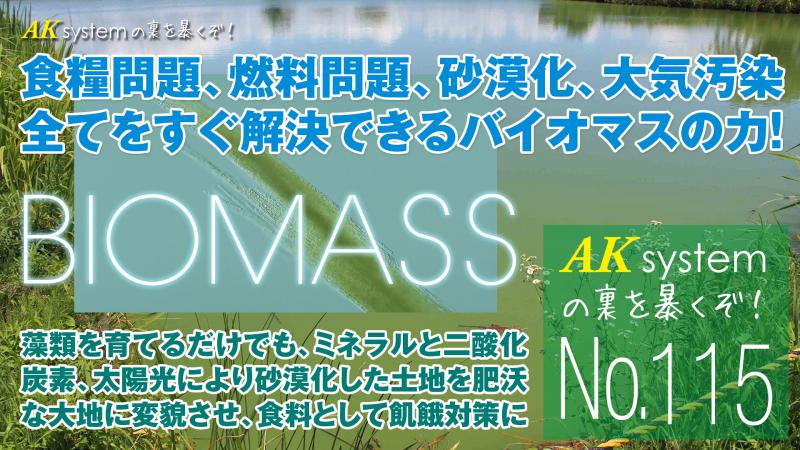バイオマスで出来る事3─バイオマスの力!【2】からの続き…藻類を育てるだけでも、ミネラルと太陽光、二酸化炭素だけで土地が肥沃になる
2022-07-21

前回はバイオマスから生成されるアルコール燃料のほうが石油製品であるガソリンより、エンジンの摩耗を防ぎ、パワーが強く、汚染物質を排出しない。開発途上国でも他国から原油を購入することなく簡単に燃料を生産できるという話題だった…
前ページは
https://keen-area.net/2022/921/
▼翻訳は下
To date the results of his efforts are a thousand farms with shelter belts and with millions of dollars' worth of pine plantations 170 miles south of Perth.
Peaty told many audiences of Australian farmers: "If each of you plants trees to slow the wind, your ground, your water, your whole environment will be brought back into balance.
Flocks of birds, long since departed, will return.
"That Peaty's vision is not utopian is proved in a moving tribute written by Jean Giono, one of southern France's most lyrical writers, to a simple French peasant, Elzeard Bouffier.
From pail after pail of collected acorns and seeds, Bouffier is credited with having single-handedly planted a forest of a million trees, covering a vast expanse of previously unparal-leled desolation, now a thriving countryside within a splendid French national preserve.
If only a million people in this or any country were each to plant a single tree, the feat could be duplicated, and the number would increase exponentially as more people planted more trees.
Only thus, and by bringing new life to a remineralized soil, can we hope to save what passes for civilization, and recover the bounty of life on this planet, the secret to which, as is patent, lives in its soil.
Our problem is with time. If Hamaker is right, we have let slip by the chance we had to plant the trees in time to save the planet from disaster.
But one last hope remains: microscopic in size but gargantuan in power, believed to be the oldest, hardiest plant form on the planet, a survivor, through billions of years, of all the hazards, imaginable and unimagina-He, dished up by an indifferent fate: the one-celled blue-green algae, known as Aphanizomenon (actually not a plant but what is now recog-nized as a bacterium).
Proliferating at great speed, the algae could, according to Daryl J.
Kollman, scientist, author, and educator, dispose of surplus CO2 and feed the world. Grown in man-made ponds all across the world, especially in such vast spaces as the Sahara Desert, the metabolizing biomass could suck up vast quantities of CO2.
No plant, says Kollman, grows fast enough to create the biomass to get us out of trouble.
To propagate blue-green algae all one needs is a pond, a pond liner, more water, and rock dust as a nutrient—all infinitely easier, cheaper, and more effective than any of the climatologists' far-out suggestions. The water does not have to flow; it needs merely to be stirred so that the in fusion of algae all get exposed to the sun.
Proliferating, the algae draw in CO2 from the air.
Harvested, says Kollman, the algae are the world's best nutrient, sufficient with their protein to save the lives of millions of slaving Africans and Third World peoples.
And if, for any reason, a batch goes bad, it makes first-rate organic fertilizer.
その結果、パースから南へ170マイルのところに1000もの農場ができ、シェルターベルトや数百万ドルの松の木のプランテーションができたのだ。
ピーティはオーストラリアの農家を前に、こう語った。「風をよけるために木を植えれば、地面も水も、環境全体がバランスを取り戻します。
そして、長い間いなくなっていた鳥の群れが戻ってくるでしょう」。
「ピーティがユートピア的でないことは、南仏で最も叙情的な作家の一人であるジャン・ジオノが、フランスの素朴な農民エルゼアール・ブフィエに書いた感動的な賛辞で証明されている。
ブフィエは、どんぐりや種を集めたペール缶から、たった一人で100万本の森を作り、それまで比類のない荒涼とした土地に、今では素晴らしいフランスの国立保護区内の田園地帯を作り上げたと言われています。
100万人が1本ずつ木を植えれば、その数は何倍にもなり、さらに多くの人が木を植えれば、その数は指数関数的に増えていく。
そうして、ミネラル分を取り戻した土壌に新しい生命を吹き込むことによってのみ、私たちは文明を救い、この惑星の生命の恵みを回復することができる。
問題は時間だ。もしハマカーが正しければ、地球を災害から救うために植樹する機会を逸してしまったことになる。
それは、地球上で最も古く、最も丈夫な植物であり、何十億年もの間、想像できるものから想像できないものまで、無関心な運命がもたらすあらゆる危険から生き残った、単細胞のアオミドロ、アファニゾメノン(実は植物ではなく、現在はバクテリアとして認識されている)である。
アファニゾメノンは高速で増殖し、科学者、作家、教育者であるダリルJ.コールマンによれば、藻類は急速に増殖し、余剰の二酸化炭素を処理し、世界を養うことができる。世界中の人工池、特にサハラ砂漠のような広大な土地で育てれば、代謝するバイオマスが膨大な量のCO2を吸い上げることができる。
コルマンによれば、どの植物も、私たちが問題を解決するためのバイオマスを作るほど速く成長することはないとのことである。
アオコを繁殖させるのに必要なのは、池、池の底板、大量の水、そして栄養分としての岩石粉である。これらはすべて、気候学者の遠大な提案よりもはるかに簡単で安価、かつ効果的である。水を流す必要はなく、ただ撹拌して、藻類が太陽の光を浴びるようにすればよい。
藻は増殖し、空気中のCO2を取り込みます。
収穫された藻類は、世界最高の栄養素であり、そのタンパク質は、奴隷として働かされるアフリカや第三世界の何百万人もの人々の命を救うのに十分であると、コルマンは言う。
そして、もし何かの理由で腐ってしまっても、一級の有機肥料になる。
Ancient organisms, algae look like bacteria but have cell walls and a far greater capacity to photosynthesize, making them the most efficient chlorophyll-producing organism in existence. Mono-cellular, each indi-vidual is self-sufficient.
Having no circulatory systems as do plants, they are mostly microscopic, though some grow into giant seaweeds, hundreds of feet long.
To Kollman, the blue-green, standing as it does at the very bottom of the food chain, is more basic to biological life than even the regular bacterium.
For billions of years it has dwelt in every drop of water and every inch of fertile soil, transforming minerals, gases, and sunlight into viable foods for bacterial, plant, and animal life, responsible directly for about 80 percent of the world's supply of food.
A few years ago, Kollman came across a supply—almost inexhausti-ble—of blue-green algae in Klamath Lake in southern Oregon, near the quiet lumber town of Klamath Falls.
The lake is 130 square miles in area, the only known accessible and unpolluted source of such algae growing wild and in abundance.
Geologists estimate that for the past ten thou-sand years the lake has had an annual procreation rate of 200 million pounds of algae, a rate that can persist indefinitely without disturbing the lake's pristine and healthy ecology.
Entirely surrounded by the beautiful Cascade Mountains, with Mount Shasta in full view some fifty miles to the south, the secret to the lake's bonanza lies in its location, a natural trap for the nutrient makings of life.
古代生物である藻類は、バクテリアに似ているが、細胞壁を持ち、光合成の能力がはるかに高く、現存する生物の中で最も効率的にクロロフィルを生産する生物である。単細胞で、個体ごとに自給自足している。
植物のような循環系を持たず、ほとんどが微小であるが、中には数百フィートの長さの巨大な海藻に成長するものもある。
コルマンは、食物連鎖の最下層に位置するアオコは、通常のバクテリアよりも生物にとって基本的な存在であるという。
何十億年もの間、水滴や肥沃な土の中に生息し、ミネラル、ガス、太陽光をバクテリア、植物、動物の生存可能な餌に変え、世界の食料の約80パーセントを直接供給してきたのである。
数年前、コルマンはオレゴン州南部のクラマス湖で、アオコが無尽蔵に発生していることに気がついた。
この湖は面積が130平方マイルもあり、アクセスしやすく、汚染されていない、アオコが大量に自生している唯一の場所として知られている。
地質学者によると、過去1万年の間、この湖では毎年2億ポンドの藻類が繁殖しており、この割合は湖の原始的で健全な生態系を乱すことなく、いつまでも続くと推定されています。
美しいカスケード山脈に囲まれ、南にはシャスタ山が見えるこの湖の大当たりの秘密は、その場所にある。
Rain and snow that fall on four thousand square miles of rich volcanic soil of the Oregon Cascades wash into Klamath Lake millions of tons of nutrient topsoil.
All the required minerals are carried down from the glaciers, available for hungry algae to turn, with their strong supply of chlorophyll and with the power of the sun, into chelated or-ganic molecules of super food—food to feed a starving planet.
To add to this nutrient supply, much of the algae have accumulated through millennia into rich sediment, which now covers the bottom of the lake to a depth of thirty-five feet.
The top one inch of this sediment alone, according to Kollman, could support a massive algae bloom for sixty years to come without any new nutrients entering the lake.
And its waters are unpolluted. In an area devoid of industry, town sewage, or the chemical toxins of agriculture, the rivers and streams that enter the lake are pure, clean, and potable, with little recreational boating where algae carpet the surface.
Kollman came to his discovery by a circuitous route.
A teacher and administrator with a master's in Science Education from Harvard, he was trained in Italy in the Montessori method.
Over a twelve-year span of teaching young children he noticed a steady increase in problems normally classified as "learning disabilities," problems he soon recognized as being associated with the diminishing quality of the children's diet.
Undernourished or poorly nourished children were not capable of absorbing information, and therefore, of learning.
We came upon Kollman in a Los Angeles suburb in the house of one of his supporters, just as he was beginning his campaign to run for President of the United States on an ecological platform.
Tall, balding, quict-spoken, in his late forties, with a deeply lined face that easily breaks into a pleasing smile, Kollman explained: "I knew that concentration was the refirst requirement for learning, and that it was getting more and more difficult for children to do so.
If I wanted to be successful in the clssroom, something had to be done to help the children's diets. An extensive computer search through existing literature revealed that micro-algae were being used in Japan and other Far Eastern countries for the remediation of poor educational performance in schoolchildren."
In 1976 Kollman and an associate became the first researchers in the United States to grow systematically and experiment with spirulina and chlorella forms of green algae now widely marketed.
But Kollman wasn't marketed: he didn't like the idea of having to grow the algae artificially in man made ponds; and the cellulose cell wall of chlorella made it difficult In simulate. The discovery of algae growing wild in one of the world's
オレゴン州カスケード山脈の豊かな火山性土壌に降る雨や雪は、クラマス湖に何百万トンもの栄養分を含んだ表土を流れ込ませる。
必要なミネラルはすべて氷河から運ばれ、飢えた藻類がその強力なクロロフィルと太陽の力でキレートまたは有機分子に変え、飢えた地球を養うスーパーフードとして利用することができる。
さらに、藻類は何千年にもわたって蓄積され、今では湖底を3.5フィートの深さまで覆う豊富な堆積物となっている。
この堆積物の上部1インチだけで、今後60年間は、新たな栄養分が湖に入ることなく、藻の大繁殖を支えることができる、とコルマンさんは言う。
しかも、その水は汚染されていない。湖に流れ込む川や小川には、工業や下水道、農業による化学毒物などがなく、純粋できれいで、飲用に適した水域である。
コルマンは、紆余曲折を経て、この発見に至った。
ハーバード大学で科学教育学の修士号を取得した教師兼管理者である彼は、イタリアでモンテッソーリ教育を受けた。
12年にわたる幼児教育の中で、通常「学習障害」と呼ばれる問題が着実に増えていることに気づいた彼は、それが子供たちの食生活の質の低下と関連していることにすぐに気がつきました。
栄養不足の子どもたちは、情報を吸収することができず、その結果、学習能力が低下していたのです。
ロサンゼルス郊外にある彼の支援者の家で、私たちはコルマンに出会った。ちょうど彼がエコロジーを掲げてアメリカ大統領選に出馬するキャンペーンを始めた頃だった。
40代後半の長身で、禿げかかった、口数の少ない、深いしわのある顔をしているが、すぐに心地よい笑みを浮かべるコールマンは、こう説明した。「集中することが学習の第一条件であり、子供たちが集中することがますます難しくなっていることを私は知っていました。
教室で成功したいのなら、子どもたちの食生活を何とかしなければならない。コンピュータで既存の文献を徹底的に検索したところ、日本をはじめとする極東の国々で、学童の教育成績の低下を改善するために微細藻類が利用されていることがわかりました" と。
1976年、コルマンと同僚は、現在広く販売されている緑藻類のスピルリナとクロレラを系統的に栽培し、実験を行った米国初の研究者となった。
人工池で人工的に藻類を育てなければならないこと、またクロレラの細胞壁がセルロースであるため、シミュレーションが困難なことが嫌だったのだ。世界有数の森林地帯で藻類が自生しているのを発見したのも、そのためだった。
richest natural "nutrient traps," completely free of artificial influences, answered for him both problems: the Aphanizomenon's cell wall was found to be composed of a substance nearly identical to glycogen, mak-ing the algae 95 percent assimilable by humans.
And the algae contain all the trace elements essential to animal and man.
To get the blue-green distributed even more widely, a system was devised for harvesting the crop during the summer, then freeze-drying it to protect the beneficial enzymes and heat-sensitive vitamins, guarantee-ing both the algae's nutritional value and the lake's ecological integrity.
The result is a 100 percent food substance, 69 percent protein, with all the trace elements in a colloidal state, readily assimilable, the highest source, according to Kollman, of natural vegetable protein and chloro-phyll in the world, containing all the essential amino acids in perfect balance, almost exactly as in the human body. As a food—in powder or capsule—he says it has no peer: one gram of blue-green algae has tested out as containing about 1,400 micrograms of beta carotene.
To obtain that much beta carotene one would have to consume 14 grams of liver, 70 grams of carrots, 14 eggs, or 5 quarts of milk.
It is also a rich source of neuro-peptides, quickly absorbed to nour-ish both the nervous system and the brain.
Kollman is said by his supporters to have been driven to his algae and to his running for the presidency by an unusual mixture of humanitarian spirit, scientific ingenuity, and social vision, a combination with which he seeks to launch a revolution in American health and in American I iutrition.
In Fallbrook, California, between Orange County and San Diego, Daryl Kollman has been building, at a cost of between half a million and a million dollars, a huge double pyramid, a hundred feet on four sides, buried fifty-five feet in the ground and rising fifty-five feet above it.
Divided into ten stories, the pyramid's purpose is to grow enough food for a large community to feed itself and have a surplus to distribute. Almost any plant can be grown in trays, fertilized with rainwater, rock dust, and blue-green algae, one gram of which contains upward of five million microorganisms.
The upper pyramid, glazed with Plexiglas, allows for the passage of solar and cosmic forces; the lower pyramid absorbs geomagnetic energy from the earth.
Some other mysterious energy inhibits the growth of mold or yeast, despite the great quantity of water that passes through the structure.
Kollman also plans to produce small pine trees that people can buy and transplant.
Other sites for double pyramids are Sedona, Santa Fe, and Albuquerque.
アファニゾメノンの細胞壁はグリコーゲンとほぼ同じ物質でできていることがわかり、藻類は95%人間に吸収されることがわかりました。
また、動物や人間に必要な微量元素をすべて含んでいます。
さらに、アオコが広く行き渡るように、夏の間に収穫した後、有益な酵素や熱に弱いビタミンを守るために凍結乾燥するシステムが考案され、藻の栄養価と湖の生態系の健全性の両方が保証されました。
その結果、100%食品、69%タンパク質、コロイド状態のすべての微量元素、容易に同化可能で、コルマンによると、世界で最も高い天然植物性タンパク質とクロロフィルの供給源であり、すべての必須アミノ酸を完璧なバランスで含み、人間の体内とほぼ同じであることが証明されました。1グラムのアオコには、約1,400マイクログラムのベータカロチンが含まれていることが確認されています。
これだけの量のβカロテンを摂取するには、レバー14グラム、ニンジン70グラム、卵14個、牛乳5クォートを摂取する必要があるそうです。
また、神経ペプチドが豊富に含まれており、素早く吸収されて神経系と脳の両方をナーリッシュにする。
コルマンは、人道的精神、科学的創意工夫、社会的展望を異常に混ぜ合わせて、アメリカの健康と栄養に革命を起こそうと、藻類を作り、大統領選に立候補したと、彼の支持者たちは言っている。
カリフォルニア州オレンジ郡とサンディエゴの間にあるフォールブルックに、ダリル・コルマンが50万ドルから100万ドルをかけて、四方100フィート、地中55フィート、地上55フィートの巨大な二重ピラミッドを建設中である。
このピラミッドは10階建てで、大きなコミュニティが自給自足し、余剰分を分配するのに十分な食料を栽培することを目的としている。トレイには、雨水、岩石粉、アオコ(1グラム中に500万個以上の微生物が含まれている)を肥料として、ほとんどすべての植物を栽培することができる。
プレキシガラスで覆われた上のピラミッドは太陽や宇宙の力を通し、下のピラミッドは地球からの地磁気エネルギーを吸収する。
また、大量の水が通るにもかかわらず、カビや酵母の繁殖を抑制する不思議なエネルギーもある。
また、小さな松の木を生産し、人々が買って移植できるようにする計画もある。
二重ピラミッドの他の候補地は、セドナ、サンタフェ、アルバカーキである。
To heat his pyramids in colder climates, Kollman envisages a machine invented by a friend in New Mexico that burns wastepaper and wood, leaving nothing but a trace of water vapor and carbon dioxide, the latter, in the enclosed pyramid, serving as extra food for the plants.
A second pyramid in Fallbrook is planned as a restaurant, general store, and bakery.
It will also serve as a communication center to spread the word.
"We have to train hundreds of thousands of people to live in such communities," says Kollman, "and we have very little time in which to do so.
"At dinner with Eddie Albert, of Green Acres fame, also a devoted supporter of organic farming and of authentic ecological revival, Ka-man expanded on his program: "The first order of business is to get the people of this country healthy.
That means cleaning up our agriculture, and restoring health to the soil.
If we don't act now to clean up the environment, we may lose forever the opportunity to do so. We are close to the upper limits of reversibility.
And the United States is the only country with the power and the influence to lead the world into a massive environmental and economic cleanup.
So far, we've left it to the 'ex-perts,' and you can see the mess they've made. They've left us 375,000 toxic waste sites to be cleaned up in the U.S.A. alone.
"To FDR's Four Freedoms we must add the freedom to have clean air, clean water, vital food, and the right to pass on to our children a world that's fit to live in.
This earth can support a lot more people.
With a little bit of intelligence, we can support them all in a way we've never seen before.
There's glacial till that's thirty to fifty feet thick in North and South Dakota; we can grind it up and move it into Iowa, Illinois, Kansas, Nebraska, Colorado, Texas, and Wyoming for vital soil and vital crops.
Meanwhile, until we grow more healthy food, the algae can bring us all the elements we lack for a revitalized, enduring health.
The blue-green algae is a gift from heaven.
But it may be the last we get if we don't shape up. We can talk about the future, and visualize the future, but if we want that future we must act."
寒冷地でのピラミッドの暖房には、ニューメキシコの友人が発明した、古紙と木材を燃やし、水蒸気と二酸化炭素を残すだけの機械を想定している。
フォールブルックにある2つ目のピラミッドは、レストラン、雑貨店、ベーカリーとして計画されています。
また、このピラミッドは、この活動を広めるためのコミュニケーションセンターにもなる。
「何十万人もの人々を、このような共同体に住めるように訓練しなければならないが、そのための時間はほとんどない」とコルマン氏は言う。
グリーン・エーカーズ』で有名なエディ・アルバートも、有機農業と本物のエコロジー再生の熱心な支持者である。「まず、この国の人たちを健康にすることです。
そのためには、農業を健全化し、土壌を健康にする必要があります。
今、環境浄化に取り組まなければ、その機会を永遠に失うことになりかねない。私たちは可逆性の上限に近づいているのです。
そして、米国は世界を環境と経済の大掃除に導くことのできる力と影響力を持った唯一の国なのです。
これまでのところ、私たちはそれを「元専門家」に任せてきた。そして、彼らが作った混乱を見ることができる。アメリカ国内だけでも37万5千もの有毒廃棄物が放置されているのだ。
FDRの「4つの自由」に、きれいな空気、きれいな水、重要な食糧を得る自由と、住むのに適した世界を子供たちに引き継ぐ権利を加えなければなりません。
この地球は、もっと多くの人を養うことができる。
ほんの少しの知恵で、今までにない方法で、すべての人々を支えることができるのです。
ノースダコタやサウスダコタには厚さ30〜50フィートの氷河堆肥があり、それを粉砕してアイオワ、イリノイ、カンザス、ネブラスカ、コロラド、テキサス、ワイオミングに運び、重要な土壌と重要な作物を作ることができるのです。
一方、私たちがより健康的な食べ物を育てるまで、藻類は私たちに不足しているすべての要素をもたらし、活性化された永続的な健康をもたらすことができるのです。
アオコは天からの贈り物です。
しかし、このままでは、これが最後の贈り物になってしまうかもしれない。未来を語り、未来を描くことはできても、その未来を望むなら、私たちは行動しなければならないのです。"
CHAPTER 19
Purified with Fire
IT TOOK THE Chernobyl disaster to arouse the Soviets to some action, belated, defensive, and far from what was needed.
In the rest of Europe, alarm at the fallout consequences mo-mentarily took people's minds, confused and helpless, off the problem of their dying trees. Not so in America, where the plague was spreading.
Satellite photos —taken five hundred miles above the earth—revealed panoramic shots of mountains dotted with dead and dying trees.
These were supple-mented by earth-based closeups of yellowing needles and lifeless branches.
To struggle with the problem, an international five-day con-ference was convened at the end of October 1987 on the shores of Lake Champlain, in the threatened Green Mountain State's city of Burling-ton. Formally entitled "The Effects of Atmospheric Pollution on Spruce and.
Fir Trees in the Eastern United States and the Federal Republic of Germany," the conference brought together a large number of forestry experts and other scientists from both countries who were studying the health of trees from space, or the condition of their roots in the soil, and everything else in between.
The general consensus admitted, as it had for nearly a decade, that American and German trees were rapidly dying for a series of reasons as complex as they were mystifying, apparently from both man-made and natural causes.
But that, as the New York Times put it in a summary article, was about the extent of the agreement.
It took Dr. Viktor Kovda, director of the U.S.S.R. Academy of Sci-ences' Institute of Soil Science, to turn attention away from what he considered more than an ample discussion of the industrial pollution of
第19章
火で浄化される
チェルノブイリ原発事故は、ソビエト連邦に何らかの行動を起こさせるのに時間がかかった。
ヨーロッパでは、放射性降下物の影響を心配し、混乱と無力感にさいなまれる人々の心を、枯れゆく樹木の問題から少しでも遠ざけようとした。しかし、疫病が蔓延しているアメリカではそうではない。
上空500マイルの衛星写真には、枯死した木々が点在する山々が写し出されていた。
また、地上からの写真では、黄ばんだ針葉樹や枯れた枝がクローズアップされている。
この問題を解決するために、1987年10月末、グリーンマウンテン州バーリントンのシャンプレーン湖畔で、5日間の国際会議が開かれた。正式名称は「アメリカ東部のトウヒとモミの木に対する大気汚染の影響」。
この会議には、宇宙から見た樹木の健康状態や、土の中の根の状態など、あらゆることを研究している両国の林業専門家やその他の科学者が多数集まった。
アメリカやドイツの木々は、人為的なものと自然的なものの両方の原因によって、複雑かつ不可解な理由で急速に枯れつつあるというのが、10年近く前から変わらない一般的な認識であった。
しかし、『ニューヨーク・タイムズ』紙に掲載された要約記事によると、その程度の認識しかなかった。
ソ連科学アカデミーの土壌科学研究所所長ビクトール・コヴダ博士が、ソ連の産業汚染に関する十分すぎるほどの議論から注意をそらす必要があった。
本書籍は以上が無料公開されていました。
この続きは書籍を購入しなければ入手できませんが、同名の書籍が以下に存在します。
ただしこの本が今回ご紹介のものと同一であるかどうかが確認(内容プレビュー機能がないため)できません。一応リンクは記載して置きます
https://amzn.to/3ohROwz
このサイトは独立したサイトでありいかなる企業とも提携していません。完全に自己資金により運営されています。
もしあなたがこのサイトの記事を良いとお考えでしたら、是非ともサポートをお願い致します。どんなに少額のサポートでも活動には有益です。
以下のリンクから、クレジットカードあるいはアマゾンペイ(コンビニ購入可能)、ペイパルでも支払い可能なサポート送金システムがあります。勿論個人情報の記載は不要です。
https://doneru.jp/AK-system
1583 : PV
関連記事
コメント一覧







